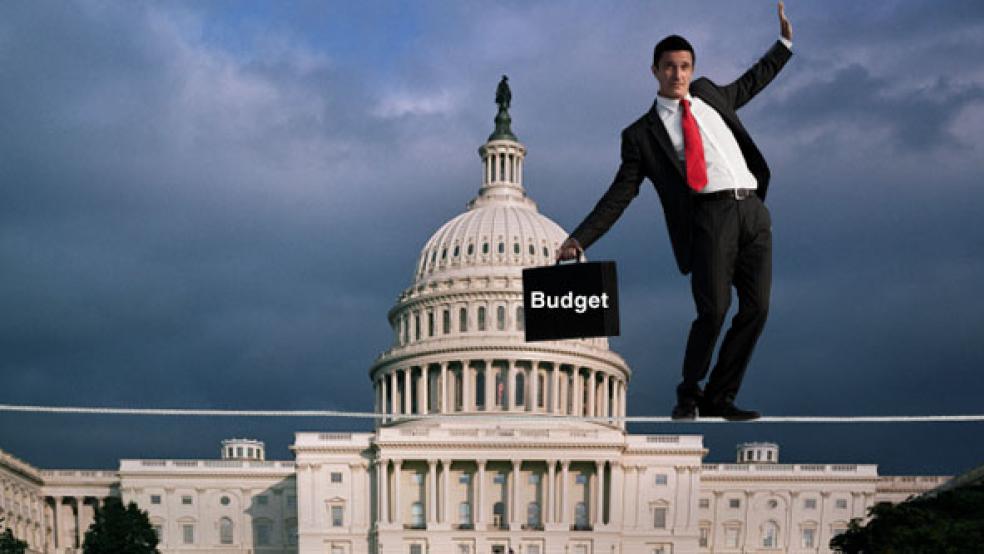Few problems receive as much lip-service and as little follow-through from political leaders as the budget deficit – a source of voter anxiety that once again appears to be a fount of broken promises in the presidential election.

Earlier this week, Republican presidential candidate Mitt Romney in New Hampshire to “show America that this team can put America on track to a balanced budget and stop the deficit spending.” But, neither Romney nor Paul Ryan, his running mate, the House Budget Committee chairman, will commit to exactly when those surpluses would start, as campaign officials have backed down from earlier pledges to eliminate the deficit by 2020.
President Obama claimed during the 2008 presidential campaign that he would halve the federal deficit by the end of his first term, with the expectation he would finish the job by 2016. Now he says that timeline has been pushed back. “We’re not there because this recession turned out to be a lot deeper than any of us realized," Obama told an Atlanta television station in February. “So, the die had been cast, but a lot of us didn’t understand at that point how bad it was going to get.”
THE HOLY GRAIL
A balanced budget was once the Holy Grail of the GOP. But it took Democratic President Bill Clinton, under pressure from Republicans, to put the government on track to four straight years of surpluses, between 1998 and 2001. Last summer, some congressional Republicans were willing to risk the first default in U.S. history to try passing a balanced budget amendment to the Constitution in exchange for votes to raise the debt ceiling.
But in the wake of the Great Recession along with the threat of falling off a fiscal cliff, four key issues are all but evaporating serious talk about balancing the budget:
• A bipartisan surge of support for increased defense spending
• A warning from CBO about extending the Bush Tax cuts
• A GOP push for enactment of another round of tax cuts for the wealthy
• A looming election to determine control of the White House and Congress
As the 2012 campaign picked up steam, lawmakers, political analysts and budget experts shifted to the far more manageable goal of stabilizing the rate of growth of the national debt. Federal debt as a percentage of Gross Domestic Product soared as the economy worsened and emergency spending increased – and it now totals $15.9 trillion. Getting the annual deficit under control became more important to policy makers than wiping it out.
“Balancing the budget kind of dropped out of the conversation in favor of the more urgent and doable goal of stabilizing the debt,” said Alice Rivlin, the first director of the Congressional Budget Office who has served on the Simpson-Bowles presidential fiscal commission and a Bipartisan Policy Center fiscal taskforce. “Then the question became, what do you stabilize it at? And the answer was, ‘Oh, well, about 60 percent of GDP,’ which seemed like a pretty good target.”
“It’s amazing how quickly the deficit went from around $160 billion in 2007 to over $1 trillion in the last several years,” lamented Robert Bixby, executive director of the Concord Coalition, a fiscally conservative advocacy group. “But the economic consensus is you don’t want a balanced budget in these times because it would slow the economic recovery. So even most traditional deficit hawks – myself included – would still say that until the economy recovers, you don’t want to get carried away with tax increases or spending cuts.”
THE EVOLUTION
The evolution of modern deficit politics has been dramatic over the past two decades. During the Clinton-era surpluses brokered with congressional Republican leaders, there was rampant interest on Capitol Hill in balanced budget amendments, spending caps, “lock boxes” and other gimmicks for controlling spending. That ended abruptly after the 9/11 terrorist attacks – producing a flood of red ink caused by two wars, two major Bush-era tax cuts, massive spending on homeland security, and the 2008 financial meltdown that drove deficit spending under Obama to levels last seen during World War II.
The government spree resulted in a showdown last summer over the debt ceiling between Obama and House Speaker John Boehner, R-Ohio, in which the government borrowing cap was lifted at the last minute in return for roughly $2.5 trillion in long-term savings and spending cuts. And both the House and Senate rejected proposals in late 2011 for a balanced budget amendment.
“It’s not as though [a balanced budget] isn’t discussed by politicians any more,” said Richard Kogan, a senior budget analyst with the left-leaning Center on Budget and Policy Priorities. “The issue is whether it’s discussed seriously.” Closing the deficit too quickly would generate the kind of economic turmoil that’s occurring in Greece, Italy and Spain, where fiscal austerity pulled those nations back into troubling downturns.
The private sector was unable to fill the void left by a downsized government, so any trimming needs to be gradual over time. With unemployment at 8.3 percent in the U.S., the deficit spending has served as an economic shock absorber. It can’t continue indefinitely, but remove it and the resulting bumps would be bruising.
“In an ideal world, you can’t cut government spending effectively until the economy is close to full employment,” said Andrew Fieldhouse, a federal budget analyst for the progressive Economic Policy Institute. “The magnitude of government spending cuts for a balanced budget amendment is beyond the realm of the tenable. We don’t have a $1 trillion waste, fraud and abuse account to tap into.”
THE ISSUE
The deficit has emerged as more of anideological issue now than one strictly about fiscal discipline. Obama, for example, would raise taxes on those making more than $250,000 a year in order to prevent steeper cuts in discretionary spending. He says his major concern is looking out for middle class Americans who would be hurt or short-changed by Republican policies.
Republicans largely link a balanced budget directly to cutting the federal budget and cutting taxes though raising additional revenues would limit the growth of debt. Dee Stewart, a former GOP congressional staffer who now heads Americans for a Balanced Budget, said lower tax rates will drive the economic growth needed to curb federal debt.
“I would reject the premise that the two are mutually exclusive,” Stewart told The Fiscal Times. “The two objectives go hand in hand.”
Polling by the Gallup Organization shows that more than 80 percent of Americans say they personally worry about federal spending and the deficit a “great deal” or a “fair amount,” and every state government except Vermont has adopted some type of balanced budget requirement. But far fewer Americans are willing to support changes that would actually put a dent in the deficit, including major savings in Medicare, Medicaid and Social Security – some of the chief engines of government spending.
As a result, the actual proposals aren’t about balancing the budget any time in the foreseeable future. And the highly celebrated plan authored by the fiscal commission headed by Republican Alan Simpson and Democrat Erskine Bowles – cutting $4 trillion off the debt through 2020 – has no chance of getting implemented.
THE CHALLENGER’S STANCE
Romney, has blasted Obama for presiding over four consecutive years of annual deficits exceeding $1 trillion. But his campaign’s stance on the deficit has noticeably softened as November approaches. Romney tempered earlier claims of a surplus by 2020, telling CBS News last week, “I’d get us to a balanced budget faster than the plan [Ryan] originally put forward” in the House – so that means eliminating the deficit sometime before 2040.” If Romney served eight years in the White House, his plan would balance the budget about two decades into his retirement.
How would Romney pull this off? After making permanent the Bush era tax cuts and introducing other tax breaks, he would cap federal spending at 20 percent of GDP. But to do that, he would have to lop $679 billion off the budget and cut several popular programs.
The next step involves battling for a balanced budget amendment that would be structured to prevent higher taxes. “A properly constructed amendment would guard against the use of net revenue increases to achieve balance by requiring a super-majority for the passage of any tax hike,” according to his economic plan.
Romney adviser Eric Fehrnstrom told CNN on Sunday that a balanced budget was “an achievable objective by the end of [a Romney] second term,” but emphasized the former Massachusetts governor’s intentions to trim $500 billion from the deficit by 2016.
THE PRESIDENT’S STANCE
That target sounds less impressive when compared to the $678 billion deficit reduction by 2016 contained in Obama’s latest budget proposal, which he submitted to Congress February 13.Obama would essentially collect more in taxes while reducing spending. Tax receipts would grow from 15.8 percent of GDP to 19.1 percent, while government outlays would drop from 24.3 percent of GDP to 22.5 percent of GDP.
He generates the projected savings by expiring the remaining Bush tax cuts ($128 billion in 2016) and implementing “other revenue proposals” (generating $97 billion). He also cuts “Overseas Contingency Operations,” which is budget-speak for ending the wars in Iraq and Afghanistan – a move that in later years saves about $100 billion annually.
But the budget projection, just like Romney’s, assumes the economy returns to humming on all cylinders. And the lingering recession hangover might be the biggest impediment to slicing into the deficit, a point made repeatedly by Fed Chairman Ben Bernanke in congressional hearings.
“As fiscal policymakers address the urgent issue of fiscal sustainability, they should take care not to unnecessarily impede the current economic recovery,” Bernanke told the Senate Budget Committee in February. “Fortunately, the two goals …are fully compatible. Indeed, they are mutually reinforcing.”





